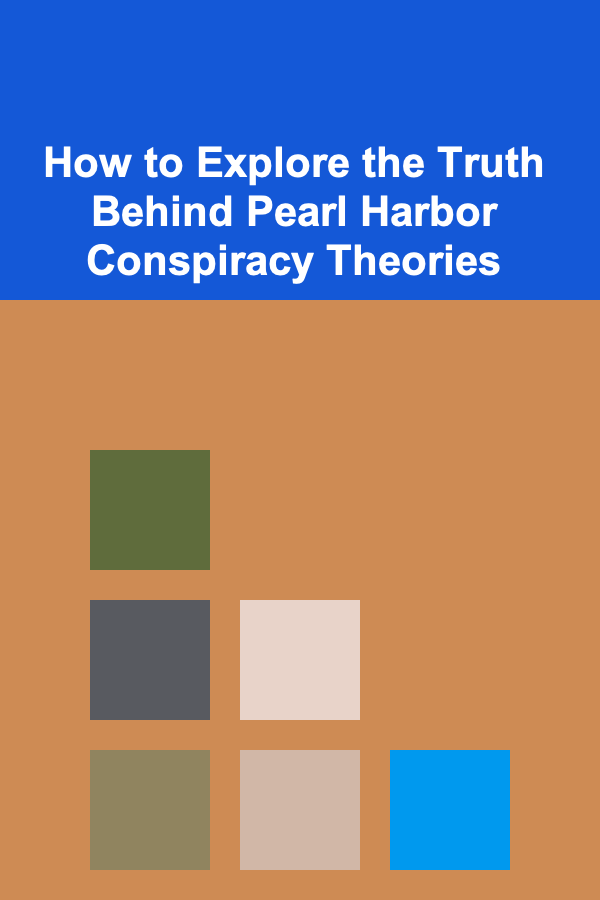
How to Explore the Truth Behind Pearl Harbor Conspiracy Theories
ebook include PDF & Audio bundle (Micro Guide)
$12.99$9.99
Limited Time Offer! Order within the next:

Pearl Harbor remains one of the most pivotal moments in modern history, an event that not only altered the course of World War II but also reshaped the global geopolitical landscape. On the morning of December 7, 1941, the Japanese military launched a surprise attack on the U.S. naval base at Pearl Harbor in Hawaii, resulting in the deaths of over 2,400 Americans and pushing the United States into the war. While the attack is well-documented and has been extensively studied, it has also spawned a range of conspiracy theories that question the official narrative. These theories suggest that there were elements within the U.S. government that may have either known about the attack in advance or even allowed it to happen for strategic purposes.
This article aims to explore the truth behind the various Pearl Harbor conspiracy theories, examining the evidence, motivations, and historical context surrounding the event. To approach this complex issue, we will break down the conspiracy theories, look at the perspectives of historians and scholars, and assess the available evidence to understand the extent to which these theories hold weight. Our exploration will not only focus on the question of government complicity but will also investigate the broader implications of such theories and the methods used to uncover historical truths.
The Official Story of Pearl Harbor
Before delving into the conspiracy theories, it is essential to first review the official story of the Pearl Harbor attack. On the morning of December 7, 1941, the Imperial Japanese Navy launched a devastating aerial attack on the U.S. naval base at Pearl Harbor, located on the island of Oahu, Hawaii. The attack lasted around two hours and resulted in the destruction of much of the U.S. Pacific Fleet. In addition to the ships and aircraft destroyed, the attack left 2,403 Americans dead and over 1,000 wounded. The strike was carried out without any prior warning, and the United States was caught completely off guard.
The reasons behind the attack are widely believed to stem from Japan's imperial ambitions in the Pacific. In the years leading up to World War II, Japan had been expanding its territory across Asia and the Pacific, which caused tension with the United States. The U.S. had imposed economic sanctions and embargoes on Japan, particularly restricting access to oil, which was essential for Japan's military operations. These sanctions, combined with Japan's desire to secure its position in the Pacific, led to the decision to attack Pearl Harbor.
The immediate consequence of the attack was that the United States declared war on Japan on December 8, 1941, marking the country's official entry into World War II. Within days, Germany and Italy, Japan's allies, declared war on the United States, thus drawing the U.S. into the European theater as well.
The Rise of Pearl Harbor Conspiracy Theories
In the decades following the attack on Pearl Harbor, numerous conspiracy theories began to circulate, suggesting that the U.S. government, or at least certain elements within it, had prior knowledge of the attack and either failed to act on that knowledge or intentionally allowed it to happen. The most prominent of these theories argue that the U.S. government had a vested interest in entering the war and that the attack provided the perfect pretext to justify a declaration of war.
One of the earliest and most influential proponents of this theory was author and historian Charles A. Beard, who, in his 1948 book President Roosevelt and the Coming of the War, argued that President Franklin D. Roosevelt had prior knowledge of Japan's plans to attack Pearl Harbor and may have even provoked Japan into attacking as a way of galvanizing public support for U.S. involvement in the war.
Since then, various authors, researchers, and historians have proposed alternative narratives of the Pearl Harbor attack, each with their own spin on the theory of government complicity or foreknowledge. While most of these theories lack solid evidence, they have nonetheless become part of popular discourse, particularly among those who are skeptical of official accounts of historical events.
Key Pearl Harbor Conspiracy Theories
1. The "Roosevelt Knew" Theory
Perhaps the most well-known conspiracy theory surrounding Pearl Harbor is the claim that President Franklin D. Roosevelt (FDR) had prior knowledge of Japan's plans to attack the U.S. base and allowed it to happen in order to justify U.S. entry into World War II. Proponents of this theory argue that Roosevelt, who had been advocating for U.S. involvement in the war in Europe, saw the attack as a necessary catalyst to bring the American public into support for war.
Supporters of the "Roosevelt knew" theory point to several pieces of evidence that they believe suggest that the U.S. government had advance warning of the attack. These include intercepted Japanese diplomatic communications, known as the "Purple Code," which indicated growing tensions between the U.S. and Japan, and reports from intelligence agencies that suggested Japan might be planning an attack on American interests in the Pacific. Additionally, some researchers argue that the U.S. had access to Japan's military codes and had intercepted communications that could have revealed Japan's intentions.
Critics of this theory argue that while there were indeed warnings about the possibility of an attack, there was no concrete evidence that Roosevelt or other high-ranking officials in the U.S. government had specific knowledge of the time and location of the attack. Furthermore, they point out that intelligence agencies were overwhelmed with information and that the attack caught them off guard despite various warnings.
2. The "The U.S. Provoked Japan" Theory
Another popular theory suggests that the U.S. deliberately provoked Japan into attacking Pearl Harbor in order to provide a justification for war. Proponents of this theory argue that the U.S. government, under President Roosevelt, had been maneuvering to push Japan into an aggressive action, particularly through economic sanctions and trade embargoes that targeted Japan's oil supply. This theory posits that the U.S. hoped to force Japan's hand and create a situation where war was inevitable, particularly with the rising threat of Nazi Germany in Europe.
This theory is often linked to the idea that Roosevelt was determined to help defeat Hitler and that entering the war was essential for preserving the democratic ideals of the United States. Some conspiracy theorists suggest that Roosevelt believed that a direct attack on the U.S. would galvanize public support for war, especially after years of isolationist sentiment in the country.
Critics of this theory argue that while the U.S. did impose economic sanctions on Japan, there is no evidence to suggest that Roosevelt actively sought to provoke an attack. In fact, most historians agree that Roosevelt had been working to prevent a war with Japan and was caught by surprise by the attack on Pearl Harbor.
3. The "Cover-Up and Deliberate Withholding of Intelligence" Theory
A related conspiracy theory suggests that the U.S. government deliberately withheld crucial intelligence information that could have prevented the attack on Pearl Harbor. This theory posits that elements within the U.S. military and intelligence agencies, possibly including high-ranking officials in the Navy and Army, failed to act on intelligence that indicated an impending attack.
One of the central pieces of evidence cited by proponents of this theory is the claim that U.S. intelligence agencies had intercepted Japanese communications that indicated a potential attack on the Pacific Fleet. Additionally, there were reports from U.S. military personnel in the Pacific who expressed concern about the vulnerability of the base to an aerial attack.
Critics argue that while there were indeed numerous warnings, the failure to prevent the attack was more likely due to a lack of coordination and miscommunication among various agencies rather than a deliberate cover-up. The intelligence community was dealing with a vast amount of information, much of which was incomplete or contradictory.
Evaluating the Evidence
When it comes to evaluating the conspiracy theories surrounding Pearl Harbor, it is important to take a measured and critical approach. While many of the claims made by conspiracy theorists are based on selective evidence or misinterpretations of historical facts, it is undeniable that there were intelligence failures leading up to the attack.
For example, the U.S. government did intercept Japanese communications that indicated growing tensions between the two nations, and there were several reports that warned of the possibility of an attack. However, these reports were often vague and lacked the specific details necessary to predict the exact timing and location of the attack. Additionally, the U.S. military was focused on the threat posed by Germany and Italy, which may have led to a certain level of complacency in monitoring the Pacific.
Furthermore, many of the key documents and reports related to the attack were classified for decades, making it difficult to fully assess the extent to which the U.S. government had advance knowledge of Japan's plans. It was only after the declassification of certain documents in the 1970s and 1980s that some of the intelligence failures leading up to the attack became more apparent.
The Importance of Understanding Historical Truth
While the Pearl Harbor conspiracy theories may never be fully proven or disproven, it is important to understand the larger lessons that can be drawn from the event. The attack on Pearl Harbor was a turning point in American history, and the questions surrounding it highlight the complexities of intelligence, diplomacy, and decision-making during times of crisis.
Understanding the historical truth behind Pearl Harbor requires not only examining the available evidence but also considering the motivations and biases of those who were involved in the event. Whether or not the U.S. government had prior knowledge of the attack, it is clear that Pearl Harbor served as a catalyst for U.S. involvement in World War II, and its legacy continues to shape American foreign policy and military strategy to this day.
Conclusion
In the end, exploring the truth behind the Pearl Harbor conspiracy theories requires a nuanced and careful examination of the available evidence. While there is no definitive proof that the U.S. government deliberately allowed the attack to happen, there are undoubtedly questions about intelligence failures and the broader geopolitical context that led to the event. The theories surrounding Pearl Harbor serve as a reminder of the complexities of historical events and the challenges of uncovering the full truth behind them. Whether one subscribes to the official account or is drawn to alternative explanations, the pursuit of historical understanding should be driven by a commitment to evidence, critical inquiry, and a willingness to confront uncomfortable truths.

How to Build a Sustainable Aloe Vera Farming Operation
Read More
How to Collaborate with Brands for Paid Partnerships
Read More
How to Create a Monthly Reading Challenge in Your Library
Read More
How to Deep Clean Your Kitchen Without the Hassle
Read More
How to Set Up a Pet Care Schedule for a Happy, Healthy Life
Read More
How to Use YouTube's Community Tab to Grow Your Channel and Revenue
Read MoreOther Products

How to Build a Sustainable Aloe Vera Farming Operation
Read More
How to Collaborate with Brands for Paid Partnerships
Read More
How to Create a Monthly Reading Challenge in Your Library
Read More
How to Deep Clean Your Kitchen Without the Hassle
Read More
How to Set Up a Pet Care Schedule for a Happy, Healthy Life
Read More